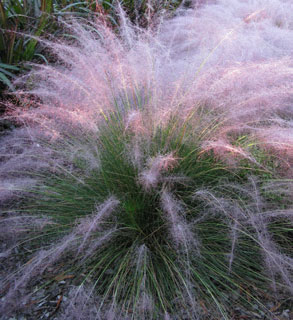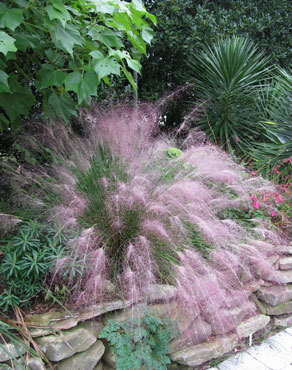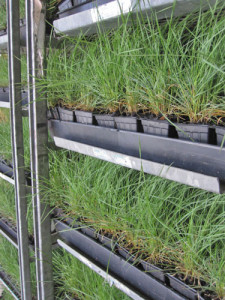 Pink Muhly Grass (Muhlenbergia capillaris) is a star in the perennial world and one of our most beautiful North American grasses. Its billowy, pink plumes enliven landscapes and stop traffic every fall. Now is the time to make sure you’ve got plenty of this outstanding grass for fall sales. It’s also a great time to plant in the landscape for a fabulous show at season’s end.
Pink Muhly Grass (Muhlenbergia capillaris) is a star in the perennial world and one of our most beautiful North American grasses. Its billowy, pink plumes enliven landscapes and stop traffic every fall. Now is the time to make sure you’ve got plenty of this outstanding grass for fall sales. It’s also a great time to plant in the landscape for a fabulous show at season’s end.
A True Performer
Muhlenbergia capillaris is a true performer, offering drought-tolerance, good looks, and quick turnaround for relatively little effort.
Fine, blue-green foliage emerges in spring. The habit is a broad and uniform, providing a neat backdrop for summer perennials. The inflorescences are delicate panicles that begin to emerge in late summer. By early fall, they create a dazzling display of pink clouds.
 Muhlenbergia capillaris is native to much of the Southeastern United States, extending as far west as Texas and Kansas and north into Massachusetts. It’s often found in arid conditions in rocky soils, so Pink Muhly has adaptations that make it a good choice for low-water landscapes. This also means it needs good drainage to remain healthy and survive wet winters. The hot and dry conditions of its native habitats often lead to a build-up of salts in the soil, but Pink Muhly is tolerant of high salinity and happily adapts to a range of soils.
Muhlenbergia capillaris is native to much of the Southeastern United States, extending as far west as Texas and Kansas and north into Massachusetts. It’s often found in arid conditions in rocky soils, so Pink Muhly has adaptations that make it a good choice for low-water landscapes. This also means it needs good drainage to remain healthy and survive wet winters. The hot and dry conditions of its native habitats often lead to a build-up of salts in the soil, but Pink Muhly is tolerant of high salinity and happily adapts to a range of soils.
Nursery/Container Production
Pot up Pink Muhly liners into 1, 2, or 3-gallon containers for fall sales. They grow relatively quickly and are not particularly sensitive to fertilizer salts. However, we suggest using a slow release fertilizer at a medium rate. Pink Muhly takes average moisture in containers and should not stay wet. Overwatering, particularly during dormancy, can be problematic. Plants can be cut back if they are too tall or floppy. If you do cut back, do so by early August so flowering is not interrupted.
In the Landscape
Pink Muhly Grass is a relatively carefree landscape plant. Although it appreciates a bit of fertilizer and regular watering at planting, it doesn’t need supplemental irrigation or nutrients once established. It’s quick to grow when temperatures warm, and it maintains its habit well into the winter season. Cut back in late winter before new growth emerges in spring.
 There are a few caveats when planting in the landscape. Muhlenbergia capillaris can struggle if winter drainage is very poor. This can be compounded by planting too late in the season. In central North Carolina, we’ve had good results installing during spring or in early fall. For fall planting, we aim to get them in the ground by mid-October at the latest.
There are a few caveats when planting in the landscape. Muhlenbergia capillaris can struggle if winter drainage is very poor. This can be compounded by planting too late in the season. In central North Carolina, we’ve had good results installing during spring or in early fall. For fall planting, we aim to get them in the ground by mid-October at the latest.
Recent Issues
Disease and insect problems have been rare, although Pink Muhly can get rust on occasion. With the wet spring and hot summer of 2013, we saw an increase in Tar Spot, a fungal disease (Phyllachora sp.) that can cause decline and dieback. It’s more likely to occur in plantings with poor air circulation, in hot and humid areas, and with excessive fertilization. It may be helpful to thin dense stands to increase air circulation. Also, cut back affected plants and dispose of the debris to prevent spread of the disease.
 Plant Ahead
Plant Ahead
As one of the most popular and easiest grasses to grow, Pink Muhly should be in everyone’s lineup. We have beautiful liners available now in 32s, 50s, and 72s ready for potting up. Check your inventory and place your order now! Just give our sales team a call at 800-203-8590 or email sales@hoffmannursery.com. For more information on Pink Muhly Grass, visit our plant profile.
